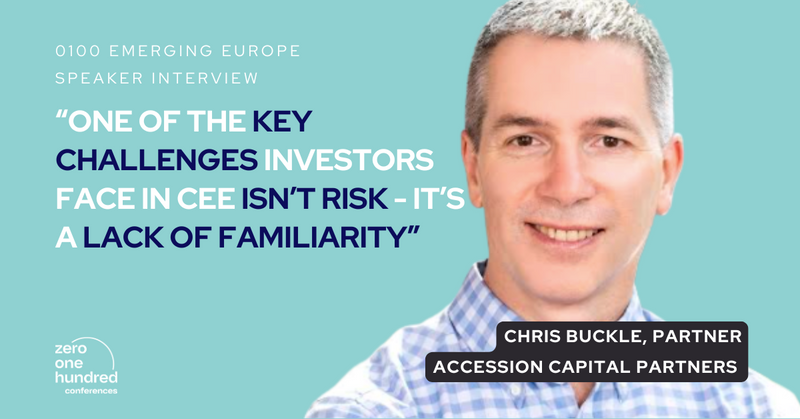In a time of shifting global capital flows and increased selectivity from LPs, Accession Capital Partners' Chris Buckle makes a compelling case for Central and Eastern Europe as a high-growth, underappreciated private capital destination. In this conversation, he shares why CEE’s mix of digital transformation, tech-savvy talent, and limited global fund competition is creating a window of opportunity for investors. Buckle also discusses how local knowledge, flexible capital, and smart exit strategies are reshaping mid-market investing in the region — and why the time to look east is now.

Chris will join the Closing Panel: Emerging Europe as the Key Investment Destination — Myth or Reality? at our upcoming 0100 Emerging Europe conference in Budapest, May 14–16. Together with William R. Watson (Value4Capital) and Edgar Kolesnik (Abris).
In your view, what makes Emerging Europe an attractive investment destination today—beyond the usual macroeconomic factors?
We normally compare Emerging Europe with its larger Western European neighbours. Nine of the ten fastest growing EU economies are in Central and Eastern Europe, all while maintaining high productivity and low unemployment.
But what makes a destination truly attractive for investment? In our view, it’s when you can achieve strong returns in a stable, transparent, and innovation-driven environment. Emerging Europe delivers exactly that. The region combines high productivity, accelerating digital transformation, and a deep pool of tech-savvy talent, while the growth of disposable income leads to strong opportunities in healthcare, pharmaceuticals, and consumer finance.
What truly sets Emerging Europe apart today, especially compared to the US or Western Europe, is the limited competition from global funds. That means better entry valuations, stronger deal positions, and, ultimately, a more attractive risk-return profile. Add to that EU integration, growing ESG momentum, stable supply chains, and strategic importance for reshoring, and this is not just a region that’s growing; it’s one that’s transforming. Investors have a real window of opportunity to get ahead of the curve.
How has the private capital landscape in Central and Eastern Europe evolved over the past few years, and what trends are you observing in terms of deal flow and investor appetite?
The private capital landscape in Central Europe has matured significantly over the past few years. We’re seeing a wave of founder-led businesses - many established in the 1990s or early 2000s - now reaching pivotal transition points. These companies are increasingly considering exits, recapitalisations or growth capital, and are seeing private equity, or growth capital funds like ours, as a strategic partner of choice.
Whilst the “Mittelstand” in Germany never generated the promised deal flow, it’s equivalent in Central Europe is buoyant, for those of us on the ground. As a firm deeply embedded in this segment, we’re seeing these shifts translate directly into actionable opportunities.
This shift, combined with growing awareness of private equity - helped by high-profile success stories like Diagnostyka’s IPO - is driving deal flow and slowly beginning to attract more investor interest to the region. We’re very much part of that momentum: 2024 has been one of our busiest years ever, with five new investments and the deployment of our largest fund to date - €336 million.
We continue to see healthy deal flow across the region. While Poland remains a major market - reflecting its size - it is by no means our sole focus. We’re seeing increased activity in Croatia, and Bulgaria is becoming more attractive as political and economic stability improves. Romania, despite its scale and potential, still lags behind in terms of actual deal activity.
What are some of the key challenges that investors face when entering or expanding in the CEE region—and how do you approach overcoming them?
One of the key challenges investors face in CEE isn’t risk - it’s a lack of familiarity. The region is often overlooked, and we’ve even seen LPs consider allocating to CEE through their 'rest of world' pocket rather than their European one - highlighting just how misunderstood it can be. At the same time, they don’t see it as a fit for their developing markets allocation either, because they rightly recognise that CEE is too advanced for that. As a result, the region often falls between the cracks of traditional global investment frameworks - despite offering fundamentals that are stronger than many better-known markets.
This unfamiliarity is compounded by a lack of regional benchmarking. There are very few truly regional private capital funds, which makes it harder for investors to evaluate performance or find reference points. It can feel like uncharted territory, even when the fundamentals and track record are increasingly compelling.
At ACP, we see it as part of our role to bridge that gap. We engage with global LPs to raise awareness, share real on-the-ground insights, and connect them directly with existing investors in our funds as we believe that this kind of peer-to-peer dialogue is often the most effective way to build trust and confidence.
The opportunity in CEE is very real. It’s just not always visible, which is why having the right partner on the ground makes all the difference.
How important is local market knowledge when it comes to successfully identifying and scaling investment opportunities in Emerging Europe?
Local market knowledge is pivotal when it comes to identifying and scaling investment opportunities in Emerging Europe. Whilst the countries of the region share many positive traits, there are also local characteristics. That’s why we’ve built a physical presence across the region, with five offices on the ground, and we’re constantly assessing whether to expand further.
This local footprint is a key reason why 12 of the 14 investments in our predecessor fund came from proprietary, relationship-driven deal flow. These weren’t auctioned or intermediated opportunities. They came through trusted networks built over years.
That’s exactly why the mid-market in Emerging Europe is so difficult to access for global funds without a local presence. You can’t buy a network. You have to build it. In our experience, that takes time, consistency, and genuine local engagement. We’ve been operating in the region for 25 years!
What role do flexible capital solutions—like growth debt or hybrid financing—play in supporting the development of mid-sized businesses in the region?
Flexible capital solutions, like growth debt or hybrid financing, are playing an increasingly important role in the development of mid-sized businesses across Emerging Europe. They fill a crucial gap between traditional bank lending and private equity, providing entrepreneurs with more tailored, strategic financing without immediately taking full control of their businesses.
Many firms in the region are well-capitalised for transactions, but they increasingly seek bespoke solutions. We’re seeing a rising demand for minority investments that allow founders to stay in control while still benefiting from external capital and expertise. Another growing trend is corporate carve-outs, as businesses reassess strategic priorities and look to divest non-core assets.
We saw this in practice with our investment in Fomtech, Slovenia, a carve-out where a flexible capital structure was key to unlocking the deal and aligning all stakeholders. These types of structures support growth, provide liquidity options, and enable transitions that might not otherwise happen through traditional means.
At ACP, our hybrid structures are designed precisely for this space. They complement banks and private equity, rather than compete with them, and don’t just fund growth but provide founders with strategic flexibility, which is often as valuable, but more difficult to attain elsewhere.
Exiting investments in Emerging Europe can be a complex process. What is your outlook on the current exit environment, and how should investors think about liquidity in this context?
Exits in Emerging Europe are often perceived as complex, but our experience tells a very different story. Since January 2024, we’ve completed seven exits and recently reached a DPI of over 100% in our predecessor fund, AMC IV, which began investing in 2017. We achieved that despite navigating the COVID pandemic, something we think speaks volumes about the maturity of the market and the resilience of our strategy.
A key factor in our approach is the structure of our growth capital funds. The debt component ensures early and steady cash flows to investors, significantly enhancing liquidity, even before full exits occur.
Also, we generally hold smaller, minority equity stakes. Therefore, an exit for our equity can be generated by a recapitalisation or buy-back, rather than sale of the whole business, which increases our, and the majority owner’s, exit options.
So, while there may be broader concerns about the exit environment, at ACP, we haven’t really felt that pressure.
More broadly, we’re seeing a growing variety of exit routes in the region, from strategic and secondary sales to IPOs, with public markets showing renewed activity. Liquidity continues to improve as the regional investor base deepens and local capital markets mature.
For investors, the key takeaway is this: exit planning in CEE requires local insight, strong networks, and flexibility - but when done right, the outcomes can rival or even exceed what you’d expect in more familiar markets.
As global investors become more selective, what would you say to those still unsure about the long-term opportunity in the CEE region? What perspectives might be missing from the broader conversation?
We rarely come across professional investors who question the long-term opportunity in Central and Eastern Europe. More often, it’s a matter of scale, unfamiliarity with the region or short-term concerns around geopolitics which dissuade investors.
LPs across Asia, the US, and Western Europe increasingly recognize the region’s long-term convergence story, which translates into growing consumer demand and structural tailwinds for investors and ultimately outperformance of Western European peers. As the pioneer provider of regional private debt funds active across CEE, we’ve been able to back that story with a strong, consistent track record.
What’s often missing from the broader conversation are the success stories that signal just how mature and investable this market has become. Take the recent IPO of Diagnostyka in Poland. It was one of the largest listings on the Warsaw Stock Exchange in the past five years and among the biggest private equity-backed public exits. We were proud to have supported Diagnostyka's earlier journey, backing MidEuropa’s buyout in 2011.
It’s also too often overlooked that many CEE companies have become leaders in their niche or national markets—and are now expanding westward, often outperforming their Western European counterparts. A great example is Optimapharm, which ACP helped to become a CEE regional champion, before TRG then took it over to spearhead a larger European consolidation.
Stories like these show that the region doesn’t just offer potential - it delivers real, scalable outcomes. They also demonstrate to entrepreneurs what a great strategic growth partner private equity can be. The long-term opportunity in CEE isn’t in question - it’s a case of communicating the opportunity, and we’re working hard to ensure more global investors see what this region truly has to offer.

